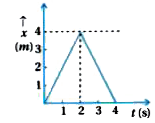The velocity of a body of mass 2 kg as a function of t is given by v(t)=2tˆi+t2ˆj . Find the momentum and the force acting on it, at time t = 2s.Solution in Gujrati
Mass of the body m=2 kg
velocity of the body v (t ) = (2t ) ˆj+(t2ˆj)
Velocity of the body at t= 2 s
=4ˆj+4ˆj
Momentum of body →p=mv=2(4ˆj+4ˆj)
Acceleration of body
a=dvdt
=ddt(2tˆj+t2ˆj)
At t =2s
(2ˆi+4ˆj)
Force acting on the body ( F ) =ma
=(4ˆi+8ˆj)N
Topper's Solved these Questions
- LAW OF MOTIONBook:KUMAR PRAKASHANChapter:LAW OF MOTIONExercise:SECTION -E(MULTIPLE CHOICE QUESTIONS) (MCQS)
Explore 69 Videos
- LAW OF MOTIONBook:KUMAR PRAKASHANChapter:LAW OF MOTIONExercise:SECTION-F (QUESTIONS FROM MODULE)
Explore 22 Videos
- LAW OF MOTIONBook:KUMAR PRAKASHANChapter:LAW OF MOTIONExercise:SECTION-C(OBJECTIVE QUESTIONS) (VSQS)
Explore 55 Videos
- GRAVITATIONBook:KUMAR PRAKASHANChapter:GRAVITATIONExercise:QUESTIONS PAPER Section - D
Explore 1 Video
- MACHANICAL PROPERTIES OF SOLIDS Book:KUMAR PRAKASHANChapter:MACHANICAL PROPERTIES OF SOLIDS Exercise:QUESTION PAPER
Explore 11 Videos
Similar Questions
The position (x) → time (t) graph of one dimensional motion of a body of mass 0.4 kg. What is the magnitude of impulse of force

View SolutionA block rests on a rough inclined plane making an angle of 30° with the horizontal. The coefficient of static friction between the block and the plane is 0.8. If the frictional force on the block is 10 N, the mass of the block ((in kg) is .......... (Take g = 10 m/s2)
View SolutionArea of F → t graph gives which physical quantity ?
View SolutionA spaceship is stationed on Mars. How much energy must be expended on the spaceship to launch it out of the solar system ? Mass of the spaceship = 1000 kg, mass of the sun =2×1030kg, mass of mars =6.4×1023kg, radius of mars = 3395 km, radius of the orbit of mars =2.28×108km,G=6.67×10−11Nm2kg2
View SolutionWhat is called brittle material ?
View SolutionThe displacement of a body of mass 2 kg veries with time t as S = t^(2) + 2t , where S is in seconds. The work done by all the forces acting on the body during the time interval t = 2s to t = 4s is
View SolutionThe mass of a body is 2.5 Kg. it is in motion and its velocity upsilon after time t is upsilon = (t^3)/(3) +(t^2)/(2) +1 Calculate the force acting on the body at the time t =3 s.
View SolutionThe velocity of a body of mass 2kg as a function of t is given by υ(t)=2tˆi+t2ˆj Find the momentum and force acting on it at time t=2s.
View SolutionA body of mass 5 kg is moving with velocity of v=(2ˆi+6ˆj)ms−1 at t=0s. After time t=2s, velocity of body is (10ˆi+6ˆj), then change in momentum to body is
View SolutionThe velocity of a body of mass 2kg as a function of t is given by υ(t)=2tˆi+t2ˆj Find the momentum and force acting on it at time t=2s.
View SolutionA particle of mass 2kg is moving such that at time t, its position, in meter, is given by barr(t)=5hati-2t^(2)hatj The angular momentum of the particle at t=2s about the origin in kg m is
View Solution2kg द्रव्यमान के किसी पिंड के वेग को समय के फलन के रूप में v(t)=2tˆi+t2ˆj से निरूपित करते हैं। t = 2s पर, इस पर लगने वाले संवेग एवं बल का परिकलन कीजिए।
View SolutionA particle of mass 2kg is moving such that at time t its position in meter is given by ¯r(t)=5ˆi−2t2ˆj. The angular momentum of the particle at t=2s about the origin in kgm−2s−1 is
View SolutionThe displacement of a body of mass 2 kg varies with time t as S = t^(2) + 2t , where S is in seconds. The work done by all the forces acting on the body during the time interval t = 2s to t = 4s is
View SolutionA body of mass 5 kg is moving with velocity of v=(2ˆi+6ˆj)ms−1 at t=0s. After time t=2s, velocity of body is (10ˆi+6ˆj), then change in momentum to body is
View Solution

